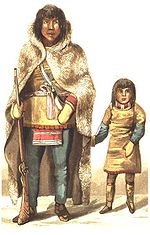Chief Akaitcho | |
|---|---|
 Portrait of Chief Akaitcho and his only son, by Robert Hood. | |
| Born | ca. 1786 |
| Died | Spring 1838 |
| Resting place | An island in Great Slave Lake's Yellowknife Bay |
| Other names | "Big-Foot", or "Big-Feet" |
| Known for | Chief of the Yellowknives |
| Relatives | François Beaulieu, brother-in-law |
Akaitcho (variants: Akaicho or Ekeicho; translation: "Big-Foot" or "Big-Feet"; meaning: "like a wolf with big paws, he can travel long distances over snow") (ca. 1786–1838) was a Copper Indian, and Chief of the Yellowknives.[1][2][3] His territory included the region from the eastern portion of the Great Slave Lake, in the Northwest Territories, Canada, to the Coppermine River, in Nunavut. He was recruited to act as interpreter, guide, and hunter for John Franklin's first of three Arctic expeditions, the Coppermine Expedition of 1819–1822.[4]
- ^ Richardson, John; C. Stuart Houston; H. Albert Hochbaum (1994). C. Stuart Houston (ed.). Arctic Ordeal: The Journal of John Richardson, Surgeon-Naturalist With Franklin 1820-1822. McGill-Queen's Press. p. 5. ISBN 0-7735-1223-3.
- ^ McIntosh, Gordon; Mary Spencer; Kay Dier (1999). Echoes in the halls: an unofficial history of the University of Alberta. University of Alberta. Association of Professors Emeriti. University of Alberta. pp. 136. ISBN 1-55220-074-4.
akaitcho big foot.
- ^ Struzik, Edward; Mike Beedell (1991). Northwest Passage: the quest for an Arctic route to the east (Digitized Oct 4, 2008 ed.). Key Porter Books. p. 63. ISBN 1-55013-181-8.
- ^ Helm, June; Beryl C. Gillespie. "Arctic Profiles" (PDF). Arctic. 36 (2): 208. doi:10.14430/arctic2266.